Bichop R.H. (Ed.) Mechatronic Systems, Sensors, and Actuators: Fundamentals and Modeling
Подождите немного. Документ загружается.

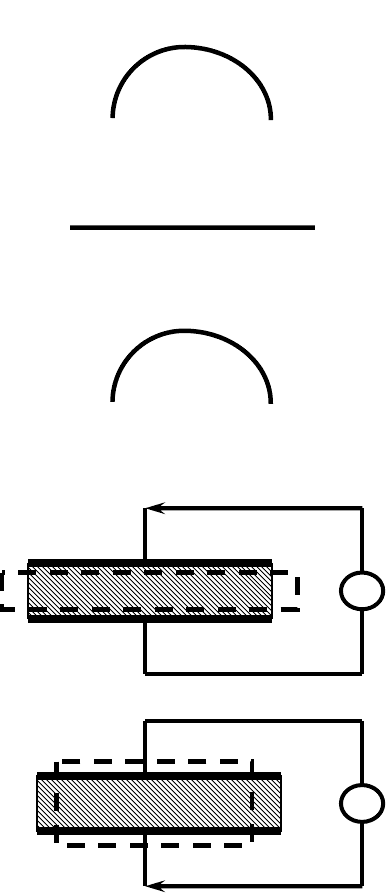
17-16 Mechatronic Systems, Sensors, and Actuators
behavior of the piezoelectric materials can be expressed as
T ⫽ c
E
S ⫺ eE
where T is the stress, c
E
is the elastic coefficient at constant electric field, S is the strain, e is the dielectric
permitivity, and E is the electric field.
One application of these actuators is as shown in Figure 17.18. The two piezoelectric patches are excited
with opposite polarity to create transverse vibration in the cantilever beam. These actuators provide high
bandwidth (0–10 kHz typical) with small displacement. Since there are no moving parts to the actuator,
it is compact and ideally suited for micro and nanoactuation.
FIGURE 17.16 Phase changes of shape memory alloy.
FIGURE 17.17 Piezoelectric actuator.
Programmed shape
austenite phase
At room temperature
straightened
martensite phase
Regains shape
when heated
austenite phase
+
+
–
–
V
V
N9258-17.fm Page 16 Thursday, October 4, 2007 9:44 PM
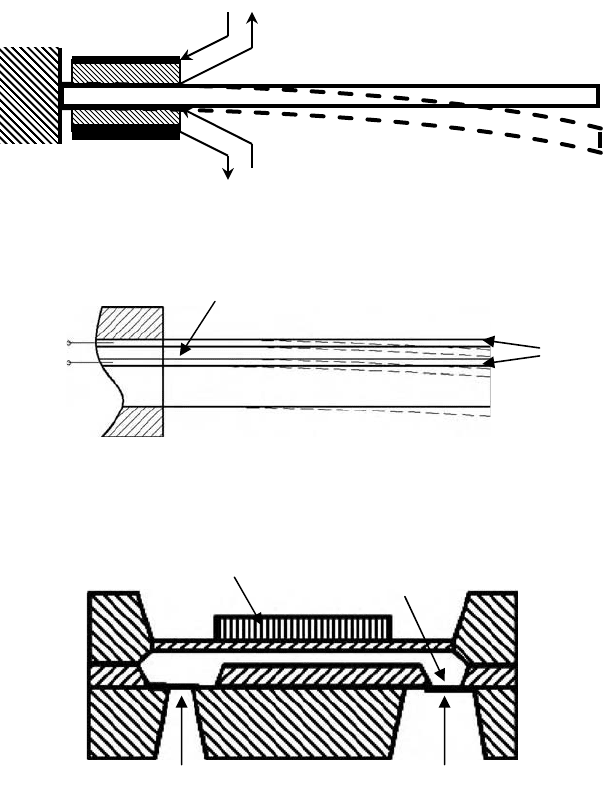
Introduction to Sensors and Actuators 17-17
Unlike the bidirectional actuation of piezoelectric actuators, the electrostriction effect is a second order
effect, that is, it responds to an electric field with unidirectional expansion regardless of polarity.
Figure 17.19 illustrates a piezo thin film actuator. Two conductors that served as top and bottom
electrodes are attached on the piezo material.When an excitation voltage is applied across the conductors,
the piezo material expands or contracts along the cantilever length direction. Thus the silicon substrate
deflects downwards or upwards. Figure 17.20 shows a typical micropump that uses piezoelectric material
as the microactuator.When the voltage is applied across the piezo disk, the disk deforms to either increase
or decrease the volume of the chamber causing the fluid to either enter or leave the chamber through the
check valves. It can operate at high frequencies in KHz range.
Magnetostrictive material is an alloy of terbium, dysprosium, and iron, which generates mechanical
strains up to 2000 microstrain in response to applied magnetic fields. They are available in the form of
rods, plates, washers, and powder. Figure 17.21 shows a typical magnetostrictive rod actuator that is
surrounded by a magnetic coil. When the coil is excited, the rod elongates in proportion to the intensity
of the magnetic field established.
FIGURE 17.18 Vibration of beam using piezoelectric actuators.
FIGURE 17.19
Piezoelectric thin film actuator. 1—Top and bottomelectrodes; 2—piezoelectric thin film; 3—Silicon
structure.
FIGURE 17.20 Silicon cantilever check valve pump. 1—Piezo disk; 2—check valve; 3—inlet; 4—outlet.
+
+
_
3
1
2
Ve ×
34
2
1
N9258-17.fm Page 17 Thursday, October 4, 2007 9:44 PM
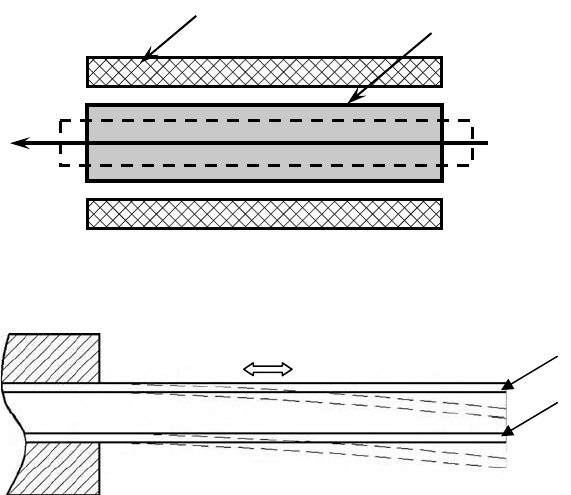
17-18 Mechatronic Systems, Sensors, and Actuators
The magneto–mechanical relationship is given as
ε ⫽ S
H
⫹ dH
where ε is the strain, S
H
is the compliance at constant magnetic filed, σ is the stress, d is the magneto-
striction constant, and H is the magnetic field intensity.
Figure 17.22 shows the schematic view of the magnetostrictive thin film actuator. On the substrate
(silicon, polyimide, gallium arsenide, etc.), Tb–Fe thin film is sputtered and on the opposite side Sm–Fe
thin film is sputtered. When a magnetic field is applied parallel to the cantilever length direction, Tb–Fe
film expands and Sm–Fe film contracts in the length direction; thus, the cantilever deflects downwards.
In the same way, when a magnetic field is applied parallel to the cantilever width direction, it deflects
upwards.
Ion exchange polymers exploit the electro-osmosis phenomenon of the natural ionic polymers for
purposes of actuation.When a voltage potential is applied across the cross-linked polyelectrolytic network,
the ionizable groups attain a net charge generating a mechanical deformation. These types of actuators
have been used to develop artificial muscles and artificial limbs. The primary advantage is their capacity
to produce large deformation with a relatively low voltage excitation.
Micro and Nanoactuators: Microactuators, also called micromachines, MEMS, and microsystems, are
the tiny mobile devices being developed utilizing the standard microelectronics processes with the
integration of semiconductors and machined mircomechanical elements. Another definition states that
any device produced by assembling extremely small functional parts of around 1–15 mm is called a
mircomachine.
In electrostatic motor electrostatic force is dominant, unlike the conventional motors that are based on
magnetic forces. For smaller micromechanical systems the electrostatic forces are well suited as an
actuating force. Figure 17.23 shows one type of electrostatic motor. The rotor is an annular disk with
uniform permitivity and conductivity. In operation, a voltage is applied to the two conducting parallel
plates separated by an insulation layer. The rotor rotates with a constant velocity between the two coplanar
concentric arrays of stator electrodes.
FIGURE 17.21 Magnetostrictive rod actuator.
FIGURE 17.22 Magnetostrictive thin film actuator. 1—Tb–Fe; 2—substrate; 3—Sm–Fe.
Coil
Magnetostrictive rod
Magnetic
field
H
1
3
2
N9258-17.fm Page 18 Thursday, October 4, 2007 9:44 PM
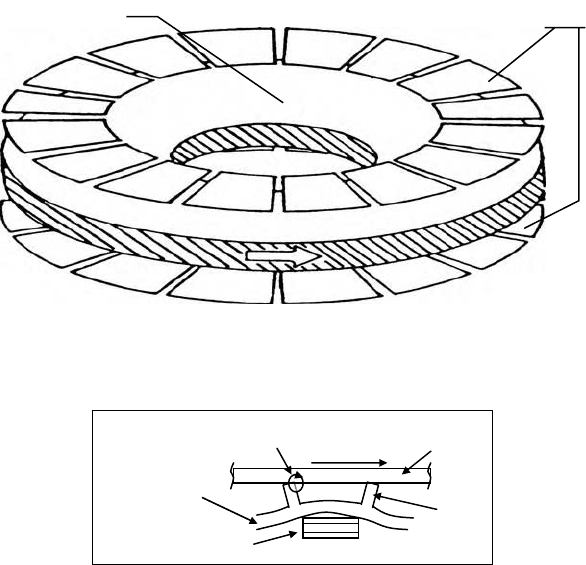
Introduction to Sensors and Actuators 17-19
In ultrasonic motors, the stator of the motor is arranged with a series of PZT crystals along the circum-
ference at regular distances. Each of the stator PZT is made to excite in a fashion that the combined effect
of all the PZTs generate a wave motion at their surface. The generated wave motion is propagated to the
elastic member of the device, which is closely packed to the PZT crystals. Teeth of the elastic member
magnify the wave and then transmit the motion to the rotor in contact. The detailed view of the
mechanism at the tip of the teeth is given in Figure 17.24. The tip of the teeth makes an elliptical motion;
friction between tip of the teeth and the rotor makes it rotate in a direction tangential to the ellipse
generated. Frequency of excitation of the PZTs determines the speed of the rotor. However, the movement
depends on many other factors such as dimensions of the elliptical shape generated, number of teeth,
and distance between the teeth.
One of the targeted applications of NEMS is in NEMS drug dispensing devices. This technology allows
a nanofabricated drug delivery device with physiologically directed accurate delivery mechanism. The
main approach to achieve this is by fabricating nanocontainers capable of releasing drugs in the body in
response to stimuli. Further, as this device is systemically injectable into the body, no surgery is required.
As this is stimuli-based delivery, added advantage of this novel device is that it dispenses drug only to
the cells that need treatment, avoiding any uncalled delivery to the normal cells.
17.1.2.3 Selection Criteria
The selection of proper actuator is more complicated than the sensors, primarily due to their effect on
the dynamic behavior of the overall system. Furthermore, the selection of actuator dominates the power
needs and the coupling mechanisms of the entire system. The coupling mechanism can sometime be
completely avoided if the actuator provides the output that can be directly interfaced to the physical
system. For example, choosing a linear motor in place of a rotary motor can eliminate the need of a
FIGURE 17.23 Electrostatic motor. 1—Rotor; 2—stator electrodes.
FIGURE 17.24 Ultrasonic motor.
1
2
Rotor
Teeth
Elliptical motion
PZT
Elastic member
N9258-17.fm Page 19 Thursday, October 4, 2007 9:44 PM
17-20 Mechatronic Systems, Sensors, and Actuators
coupling mechanism to convert rotary motion to linear motion. In general, the following performance
parameters must be addressed before choosing an actuator for a specific need:
Continuous power output: The maximum force/torque attainable continuously without exceeding the
temperature limits.
Range of motion: The range of linear/rotary motion.
Resolution: The minimum increment of force/torque attainable.
Accuracy: Linearity of the relationship between the input and output.
Peak force/torque: The force/torque at which the actuator stalls.
Heat dissipation: Maximum wattage of heat dissipation in continuous operation.
Speed characteristics: Force/torque versus speed relationship.
No load speed: Typical operating speed/velocity with no external load.
Frequency response: The range of frequency over which the output follows the input faithfully, applicable
to linear actuators.
Power requirement: Type of power (ac or dc), number of phases, voltage level, and current capacity.
In addition to the above-referred criteria, many other factors become important depending on the
type of power and the coupling mechanism required. For example, if a rack and pinion coupling
mechanism is chosen, the backlash and friction will affect the resolution of the actuating unit.
N9258-17.fm Page 20 Thursday, October 4, 2007 9:44 PM

18-1
18
Fundamentals of Time
and Frequency
18.1 Introduction ............................................................. 18-1
Coordinated Universal Time
18.2 Time and Frequency Measurement ........................ 18-2
Accuracy
•
Stability
18.3 Time and Frequency Standards .............................. 18-9
Quartz Oscillators
•
Rubidium Oscillators
•
Cesium Oscillators
18.4 Time and Frequency Transfer ................................. 18-13
Fundamentals of Time and Frequency Transfer
•
Radio Time and Frequency Transfer Signals
18.5 Closing ...................................................................... 18-17
References .............................................................................. 18-17
18.1 Introduction
Time and frequency standards supply three basic types of information:
time-of-day,
time interval
, and
frequency
. Time-of-day information is provided in hours, minutes, and seconds, but often also includes
the
date
(month, day, and year). A device that displays or records time-of-day information is called a
clock
.
If a clock is used to label when an event happened, this label is sometimes called a
time tag
or
time stamp
.
Date and time-of-day can also be used to ensure that events are
synchronized
, or happen at the same time.
Time interval is the duration or elapsed time between two events. The standard unit of time interval
is the second(s). However, many engineering applications require the measurement of shorter time
intervals, such as milliseconds (1 ms = 10
−3
s), microseconds (1 µs = 10
−6
s), nanoseconds (1 ns = 10
−9
s),
and picoseconds (1 ps = 10
−12
s). Time is one of the seven base physical quantities, and the second is one
of seven base units defined in the International System of Units (SI). The definitions of many other
physical quantities rely upon the definition of the second. The second was once defined based on the
earth’s rotational rate or as a fraction of the tropical year. That changed in 1967 when the era of atomic
time keeping formally began. The current definition of the SI second is:
The duration of 9,192,631,770 periods of the radiation corresponding to the transition between two
hyperfine levels of the ground state of the cesium-133 atom.
Frequency is the rate of a repetitive event. If
T
is the period of a repetitive event, then the frequency
f
is its reciprocal, 1/
T
. Conversely, the period is the reciprocal of the frequency,
T
=
1/
f
. Since the period
is a time interval expressed in seconds (s), it is easy to see the close relationship between time interval
and frequency. The standard unit for frequency is the hertz (Hz), defined as events or cycles per second.
The frequency of electrical signals is often measured in multiples of hertz, including kilohertz (kHz),
megahertz (MHz), or gigahertz (GHz), where 1 kHz equals one thousand (10
3
) events per second, 1 MHz
Michael A. Lombardi
National Institute of Standards
and Technology
9258_C018.fm Page 1 Tuesday, October 2, 2007 1:22 AM

18-2 Mechatronic Systems, Sensors, and Actuators
equals one million (10
6
) events per second, and 1 GHz equals one billion (10
9
) events per second.
A device that produces frequency is called an
oscillator
. The process of setting multiple oscillators to the
same frequency is called
syntonization
.
Of course, the three types of time and frequency information are closely related. As mentioned, the
standard unit of time interval is the second. By counting seconds, we can determine the date and the
time-of-day. And by counting events or cycles per second, we can measure frequency.
Time interval and frequency can now be measured with less uncertainty and more resolution than
any other physical quantity. Today, the best time and frequency standards can realize the SI second with
uncertainties of . Physical realizations of the other base SI units have much larger uncertainties,
as shown in Table 18.1 [1–5].
18.1.1 Coordinated Universal Time (UTC)
The world’s major metrology laboratories routinely measure their time and frequency standards and
send the measurement data to the Bureau International des Poids et Measures (BIPM) in Sevres, France.
The BIPM averages data collected from more than 200 atomic time and frequency standards located at
more than 40 laboratories, including the National Institute of Standards and Technology (NIST). As a
result of this averaging, the BIPM generates two time scales, International Atomic Time (TAI), and
Coordinated Universal Time (UTC). These time scales realize the SI second as closely as possible.
UTC runs at the same frequency as TAI. However, it differs from TAI by an integral number of seconds.
This difference increases when leap seconds occur. When necessary, leap seconds are added to UTC on
either June 30 or December 31. The purpose of adding leap seconds is to keep atomic time (UTC) within
±0.9 s of an older time scale called UT1, which is based on the rotational rate of the earth. Leap seconds
have been added to UTC at a rate of slightly less than once per year, beginning in 1972 [3,5].
Keep in mind that the BIPM maintains TAI and UTC as ‘‘paper’’ time scales. The major metrology
laboratories use the published data from the BIPM to steer their clocks and oscillators and generate real-
time versions of UTC. Many of these laboratories distribute their versions of UTC via radio signals, which
are discussed in section 18.4.
You can think of UTC as the ultimate standard for time-of-day, time interval, and frequency. Clocks
synchronized to UTC display the same hour, minute, and second all over the world (and remain within
one second of UT1). Oscillators syntonized to UTC generate signals that serve as reference standards for
time interval and frequency.
18.2 Time and Frequency Measurement
Time and frequency measurements follow the conventions used in other areas of metrology. The fre-
quency standard or clock being measured is called the device under test (DUT ). A measurement compares
the DUT to a standard or reference. The standard should outperform the DUT by a specified ratio, called
the test uncertainty ratio (TUR). Ideally, the TUR should be 10:1 or higher. The higher the ratio, the less
averaging is required to get valid measurement results.
TABL E 1 8. 1 Uncertainties of Physical Realizations
of the Base SI Units
SI Base Unit Physical Quantity Uncertainty
Candela Luminous intensity 1 × 10
−4
Kelvin Temperature 3 × 10
−7
Mole Amount of substance 8 × 10
−8
Ampere Electric current 4 × 10
−8
Kilogram Mass 1 × 10
−8
Meter Length 1 × 10
−12
Second Time interval 1 × 10
−15
110
15–
×≅
9258_C018.fm Page 2 Tuesday, October 2, 2007 1:22 AM
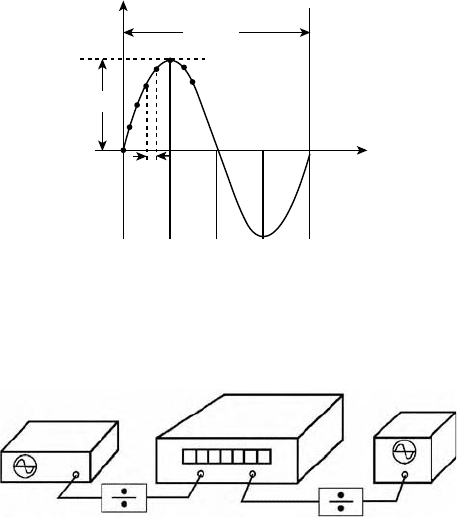
Fundamentals of Time and Frequency 18-3
The test signal for time measurements is usually a pulse that occurs once per second (1 pps). The
pulse width and polarity varies from device to device, but TTL levels are commonly used. The test signal
for frequency measurements is usually at a frequency of 1 MHz or higher, with 5 or 10 MHz being
common. Frequency signals are usually sine waves, but can also be pulses or square waves. If the frequency
signal is an oscillating sine wave, it might look like the one shown in Figure 18.1. This signal produces
one cycle (360° or 2
π
radians of phase) in one period. The signal amplitude is expressed in volts, and
must be compatible with the measuring instrument. If the amplitude is too small, it might not be able
to drive the measuring instrument. If the amplitude is too large, the signal must be attenuated to prevent
overdriving the measuring instrument.
This section examines the two main specifications of time and frequency measurements—accuracy
and stability. It also discusses some instruments used to measure time and frequency.
18.2.1 Accuracy
Accuracy is the degree of conformity of a measured or calculated value to its definition. Accuracy is
related to the offset from an ideal value. For example, time offset is the difference between a measured
on-time pulse and an ideal on-time pulse that coincides exactly with UTC. Frequency offset is the difference
between a measured frequency and an ideal frequency with zero uncertainty. This ideal frequency is
called the nominal frequency.
Time offset is usually measured with a time interval counter (TIC), as shown in Figure 18.2. A TIC
has inputs for two signals. One signal starts the counter and the other signal stops it. The time interval
between the start and stop signals is measured by counting cycles from the time base oscillator. The
resolution of a low cost TIC is limited to the period of its time base. For example, a TIC with a 10-MHz
time base oscillator would have a resolution of 100 ns. More elaborate TICs use interpolation schemes
to detect parts of a time base cycle and have much higher resolution—1 ns resolution is commonplace,
and 20 ps resolution is available.
FIGURE 18.1 An oscillating sine wave.
FIGURE 18.2 Measurement using a time interval counter.
0
–
+
A
T= 1/f
T
s
= 1/f
s
f = frequency
A = amplitude
T = period
90 180 270 360
degrees
radians
Voltage
Time, t
0
π
/2
π
3 /2
π
2
π
Dut
Ch. B
Ch. A
Out
Out
Stop
Start
Reference
oscillator
Counter
9258_C018.fm Page 3 Tuesday, October 2, 2007 1:22 AM
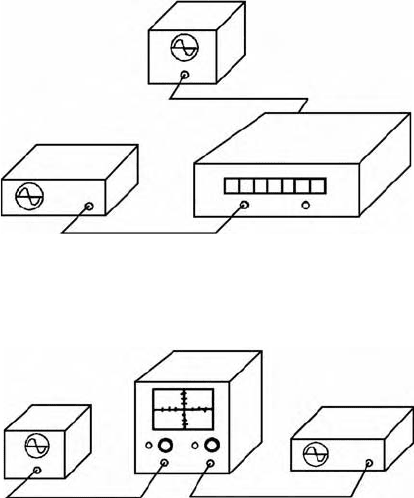
18-4 Mechatronic Systems, Sensors, and Actuators
Frequency offset can be measured in either the frequency domain or time domain. A simple frequency
domain measurement involves directly counting and displaying the frequency output of the DUT with
a frequency counter. The reference for this measurement is either the counter’s internal time base oscillator,
or an external time base (Figure 18.3). The counter’s resolution, or the number of digits it can display, limits
its ability to measure frequency offset. For example, a 9-digit frequency counter can detect a frequency
offset no smaller than 0.1 Hz at 10 MHz (1 × 10
−8
). The frequency offset is determined as
where f
measured
is the reading from the frequency counter, and f
nominal
is the frequency labeled on the
oscillator’s nameplate, or specified output frequency.
Frequency offset measurements in the time domain involve a phase comparison between the DUT and
the reference. A simple phase comparison can be made with an oscilloscope (Figure 18.4). The oscillo-
scope will display two sine waves (Figure 18.5). The top sine wave represents a signal from the DUT, and
the bottom sine wave represents a signal from the reference. If the two frequencies were exactly the same,
their phase relationship would not change and both would appear to be stationary on the oscilloscope
display. Since the two frequencies are not exactly the same, the reference appears to be stationary and
the DUT signal moves. By measuring the rate of motion of the DUT signal we can determine its frequency
offset. Vertical lines have been drawn through the points where each sine wave passes through zero. The
bottom of the figure shows bars whose width represents the phase difference between the signals. In this
case the phase difference is increasing, indicating that the DUT is lower in frequency than the reference.
Measuring high accuracy signals with an oscilloscope is impractical, since the phase relationship
between signals changes very slowly and the resolution of the oscilloscope display is limited. More precise
phase comparisons can be made with a TIC, using a setup similar to Figure 18.2. If the two input signals
have the same frequency, the time interval will not change. If the two signals have different frequencies,
FIGURE 18.3 Measurement using a frequency counter.
FIGURE 18.4 Phase comparison using an oscilloscope.
DUT
Ch. B
Ch. A
Out
Out
Reference
oscillator
Counter
DUT
Ch. 1
Ch. 2
Out
Out
Reference
oscillator
Oscilloscope
f offset()
f
measured
f
nominal
–
f
nominal
--------------------------------------
=
9258_C018.fm Page 4 Tuesday, October 2, 2007 1:22 AM
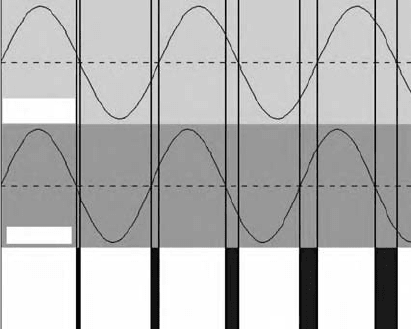
Fundamentals of Time and Frequency 18-5
the time interval will change, and the rate of change is the frequency offset. The resolution of a TIC
determines the smallest frequency change that it can detect without averaging. For example, a low cost
TIC with a single-shot resolution of 100 ns can detect frequency changes of 1 × 10
−7
in 1 s. The current
limit for TIC resolution is about 20 ps, which means that a frequency change of 2 × 10
−11
can be detected
in 1 s. Averaging over longer intervals can improve the resolution to <1 ps in some units [6].
Since standard frequencies like 5 or 10 MHz are not practical to measure with a TIC, frequency dividers
(shown in Figure 18.2) or frequency mixers are used to convert the test frequency to a lower frequency.
Divider systems are simpler and more versatile, since they can be easily built or programmed to accom-
modate different frequencies. Mixer systems are more expensive, require more hardware including an
additional reference oscillator, and can often measure only one input frequency (e.g., 10 MHz), but they
have a higher signal-to-noise ratio than divider systems.
If dividers are used, measurements are made from the TIC, but instead of using these measurements
directly, we determine the rate of change from reading to reading. This rate of change is called the phase
deviation. We can estimate frequency offset as follows:
where ∆t is the amount of phase deviation, and T is the measurement period.
To illustrate, consider a measurement of +1
µ
s of phase deviation over a measurement period of 24 h.
The unit used for measurement period (h) must be converted to the unit used for phase deviation (
µ
s).
The equation becomes
As shown, a device that accumulates 1
µ
s of phase deviation/day has a frequency offset of −1.16 × 10
−11
with respect to the reference. This simple example requires only two time interval readings to be made,
and ∆t is simply the difference between the two readings. Often, multiple readings are taken and the
frequency offset is estimated by using least squares linear regression on the data set, and obtaining ∆t
from the slope of the least squares line. This information is usually presented as a phase plot, as shown
in Figure 18.6. The device under test is high in frequency by exactly 1 × 10
−9
, as indicated by a phase
deviation of 1 ns/s [2,7,8].
FIGURE 18.5 Two sine waves with a changing phase relationship.
Device under
test (DUT)
Reference
Phase
difference
f offset()
∆t–
T
---------
=
f offset()
∆t–
T
---------
1 µs–
86,400,000,000
µ
s
--------------------------------------------
1.16 10
11–
×–== =
9258_C018.fm Page 5 Tuesday, October 2, 2007 1:22 AM
